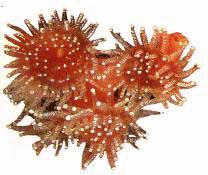 Coelenterates include the corals, sea anemones, jellyfishes, and hydroids (the Portugese man-of-war is a colonial hydroid). Many possess a highly developed stinging unit (the nematocyst) that can penetrate the skin. These are particularly abundant on the animal’s tentacles, and a single tentacle may fire thousands of nematocysts into the skin following contact. The lesions vary with the type of coelenterate involved. Generally, the initial lesions appear as small papular eruptions in one or several discontinuous lines, which develop quickly, and the area becomes red and raised. This may be accompanied by severe pain and itching. The papules my pustulate and desquamate. Systemic symptoms include weakness, nausea, headache, muscle pain and spasms, lacrimation and nasal discharge, increased perspiration, changes in pulse rate, and chest pain that increases on respiration. The sting of the Portugese man-of-war has caused deaths in North America.
Coelenterates include the corals, sea anemones, jellyfishes, and hydroids (the Portugese man-of-war is a colonial hydroid). Many possess a highly developed stinging unit (the nematocyst) that can penetrate the skin. These are particularly abundant on the animal’s tentacles, and a single tentacle may fire thousands of nematocysts into the skin following contact. The lesions vary with the type of coelenterate involved. Generally, the initial lesions appear as small papular eruptions in one or several discontinuous lines, which develop quickly, and the area becomes red and raised. This may be accompanied by severe pain and itching. The papules my pustulate and desquamate. Systemic symptoms include weakness, nausea, headache, muscle pain and spasms, lacrimation and nasal discharge, increased perspiration, changes in pulse rate, and chest pain that increases on respiration. The sting of the Portugese man-of-war has caused deaths in North America.
TREATMENT
Changing the PH of the skin by local applications of meat tenderizers (eg, papain), sodium bicarbonate, boric acid, lemon or fig juice, alcohol and other agents can alleviate some of the localized pain.
Suggested procedures include: ocean water (not fresh) is poured over the injured areas; the tentacles are removed, preferably with an instrument or gloved hand; the area is soaked in 50% vinegar for 30 minutes; flour or baking powder is then poured over the wound area and scraped off with a sharp knife; the area is rinsed, soaked again in vinegar, and a topical anthistamine-analgesic-corticosteroid balm is applied.
More serious injuries may require oxygen or respiratory assistance. For severe pain meperidine is preferred. IV fluids and epiniphrine may be needed in case of shock, which is rare.

